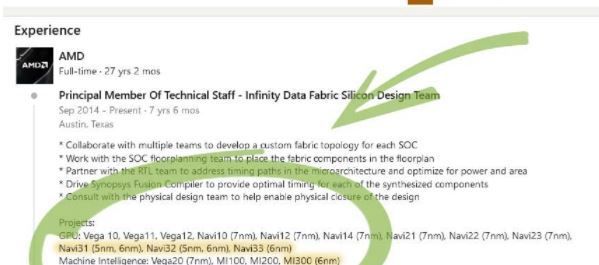AMD Engineer Confirms Work on RDNA 3 Navi 3X GPUs at 5 and 6nm
AMD RDNA 3 architecture Navi 31, Navi 32, and Navi 33 GPUs are mentioned.
An AMD Infinity Data Fabric Silicon Design Engineer has perhaps been a little overeager in revealing his impressive work experience on LinkedIn. The social network posting from an AMD employee based at the Austin offices mentions several products that are yet to be officially launched, alongside details about their manufacturing node. Specifically, the listing includes several Navi 3X GPUs (which are due this year) and a brand new Instinct accelerator card, which might not be officially unveiled until Q2 or Q3 2022. The LinkedIn gaffe was spotted by @blueisviolet and brought to our attention by @davideneco25320.

A section of the post (sub-headed "Projects") says that current/past projects include work on "Navi31 (5nm, 6nm), Navi32 (5nm, 6nm), Navi33 (6nm)… [and] MI300 (6nm)." Taking this at face value, the information suggests that both Navi 31 and Navi32 will be multi-chip-module (MCM) GPUs using a mix of fabrication nodes. Thus, larger Navi 31 and Navi32 are likely hybrid architecture GPUs.
Moving down the Navi 3X ranks (remember bigger numbers are the smaller GPUs), the Navi 33 GPU is probably sticking to a monolithic GPU design, with the single die fabricated at 6nm. It will be very interesting to see RDNA 3 graphics cards launch with this mix of MCM and monolithic GPUs. However, AMD has a good track record of similar progression with CPUs and Instinct accelerators, so there isn't much concern about the bigger consumer GPUs going hybrid.
When the Navi 3X GPUs arrive, consumers will know them as the AMD Radeon RX 7000 Series. It is probably still too early to make sensible predictions about the GPU configurations of these cards (cores, speeds, memory, etc.), but rumors suggest that Navi 3X will be a significant update.
Last but not least, for data center and HPC folk, it is good to see the AMD Instinct MI300 surfaced by the insider source. Of course, the current Instinct top-dog, the MI200, already features an MCM GPU, which we think is feeding down to the consumer GPUs. AMD Instinct MI300 will be more of the same, tweaked and beefed up to compete against the best from Nvidia and new entrant Intel.
AMD confirmed that both RDNA 3 GPUs and Zen 4 CPUs would be coming sometime in 2022 in a presentation last summer, and various execs have restated this timescale in the interim.
Get Tom's Hardware's best news and in-depth reviews, straight to your inbox.

Mark Tyson is a news editor at Tom's Hardware. He enjoys covering the full breadth of PC tech; from business and semiconductor design to products approaching the edge of reason.
-
-Fran- Reply
I'm sure they'll be better than your comment :Dpeachpuff said:Hope they'll be faster than the 6500xt...
Regards. -
$h0nuff Having a hard time getting on board with this. One product line on two different nodes? The cost and risk factors alone..Reply
Perhaps the dude was involved in tape-out projects for the same design on both nodes. -
LuxZg Hmm, this 5/6nm indeed is weird. Hybrid MCM doesn't make much sense either, EXCEPT if they are doing infinity cache on different node vs the execution units. Likewise, having two same essentially same designs on two nodes wouldn't make sense at all. If it said just RDNA3 on 5nm & 6nm I'd say ok, lower/higher end models on different nodes, or embedded GPU based on RDNA3 for CPU on different node. But saying specifically that eg Navi32 is both 5&6nm is weird... Except as I said, if the different node is just for cache (or some I/O die, which wouldn't be news at all).Reply
Now that I just wrote that, if 31/32 are MCM it's enough that I/O & interconnect is 5nm and it would cover the weird two-node description. We're probably just reading too much into it. -
-Fran- There's a lot of reasons why the same architecture can be in multiple nodes, specially at the same manufacturer with "backwards compatible" tooling. Remember one of the promises of TSMC's 7 6 and 5 (IIRC) were all "backportable", so it would make sense for AMD to explore both options for the manufacturing. Imagine you make the same chip in 6nm and in 5nm, where one part clocks higher and the other doesn't, but the yields are basically the same; you can have 2 lines of products out of those. And then there's the multi-chip approach, which is more of an "obvious" possibility.Reply
Then again, we may be reading way too much into it and it really doesn't mean much. Heh.
Regards. -
saltweaver Reply
Hope they'll be cheaper than 6500xt...peachpuff said:Hope they'll be faster than the 6500xt... -
jp7189 I'm reading this as multiple 5nm gpus connecting through a 6nm chiplet with infinity cache, memory controllers, pcie. I see infinity cache as the key to "hiding" the problems of multiple gpu chiplets. Truly exciting if they can make it work. Imagine 2x gpus in the mid range, 4x on the top end, and up to 8x in the datacenter.Reply -
JayNor Replyjp7189 said:Imagine 2x gpus in the mid range, 4x on the top end, and up to 8x in the datacenter.
Intel showed a quad Ponte Vechio OAM water cooled module in Jeff McVeigh's SC21 keynote. There are OAM accelerator baseboards that support 8 OAM modules. -
jp7189 Reply
I can see that working well for AI/HPC, but I can also see some challenges for frametime consistency in gaming. That's why I think infinity cache is a breakthrough for gaming.JayNor said:Intel showed a quad Ponte Vechio OAM water cooled module in Jeff McVeigh's SC21 keynote. There are OAM accelerator baseboards that support 8 OAM modules.